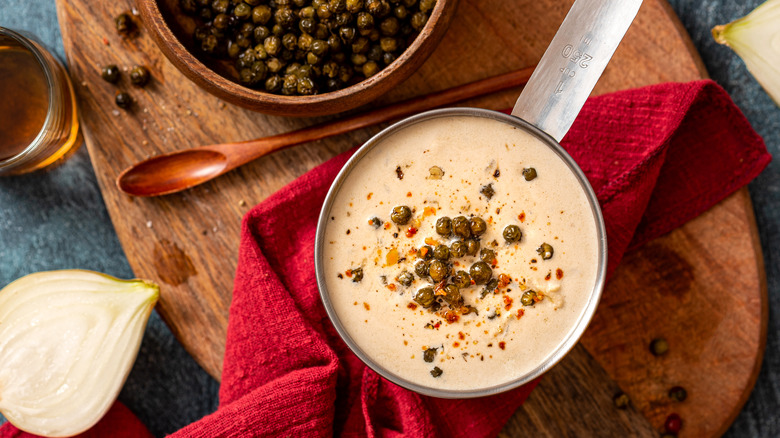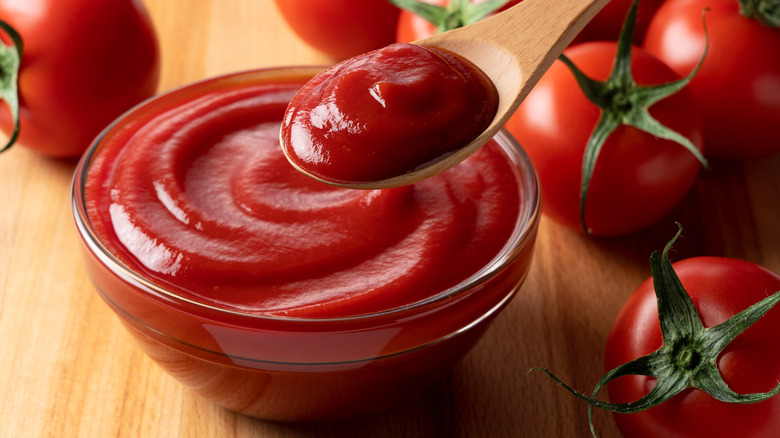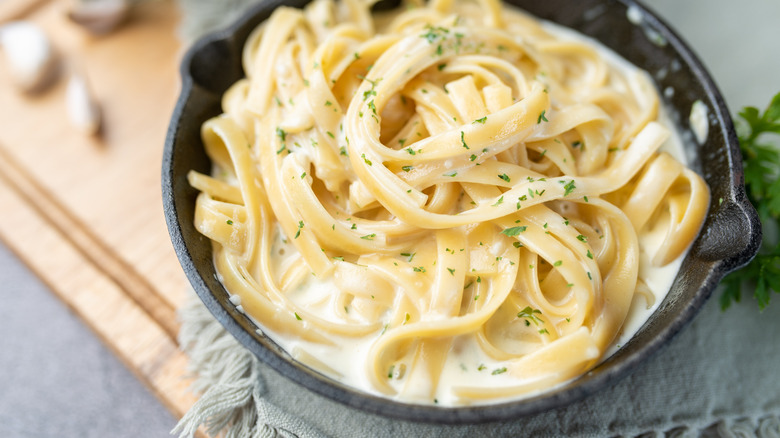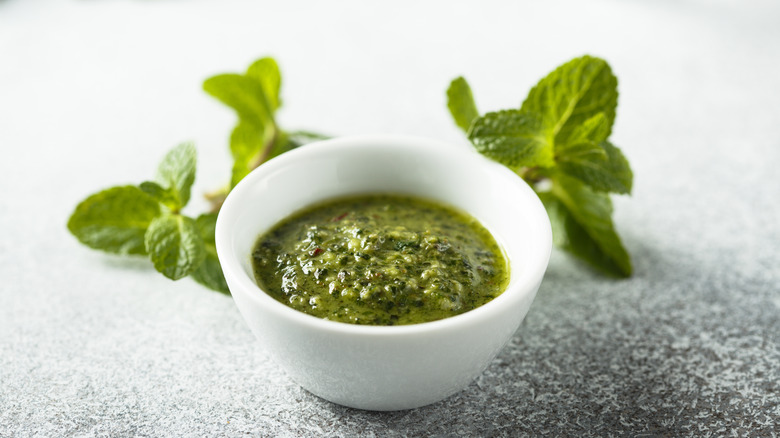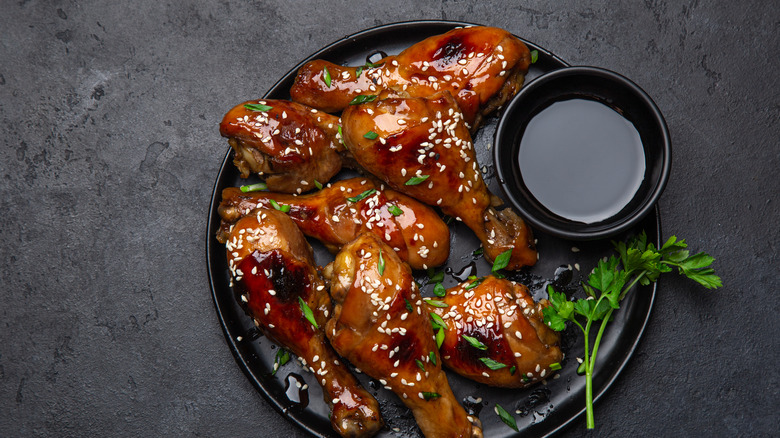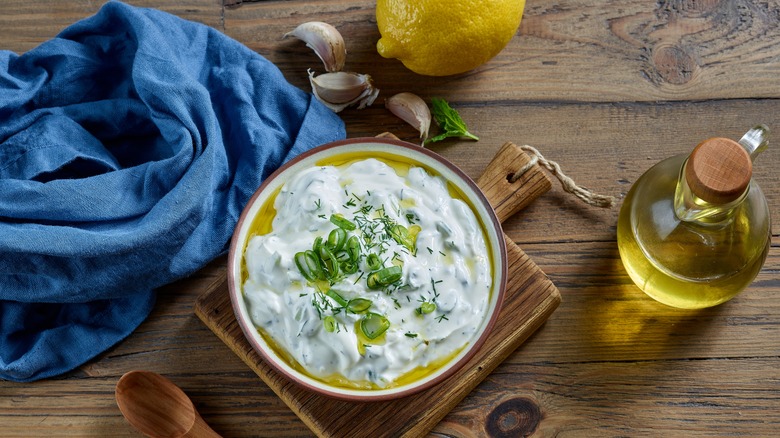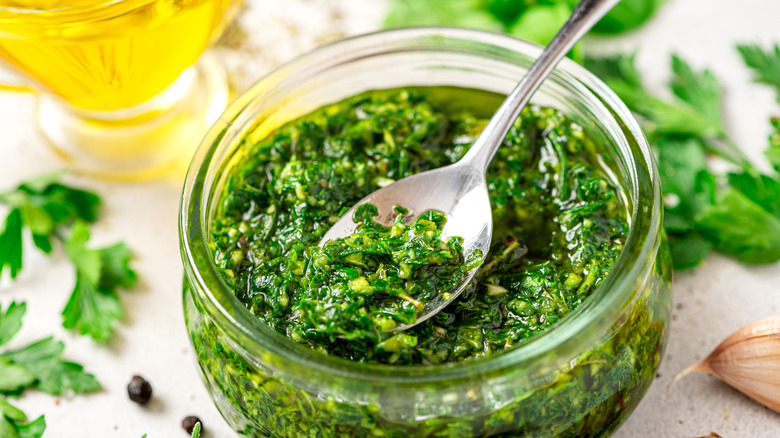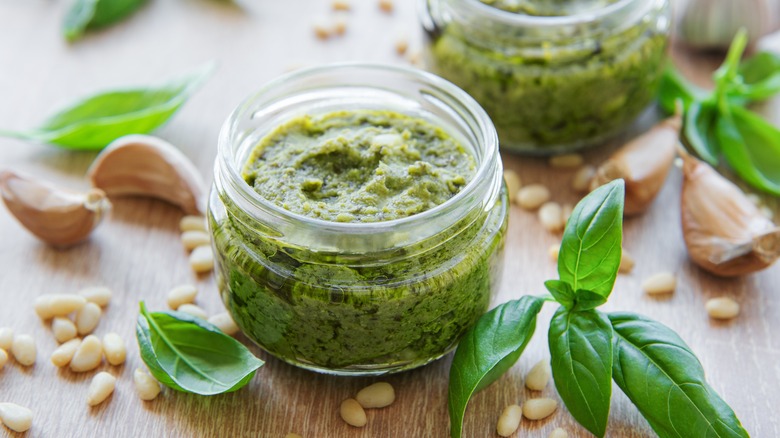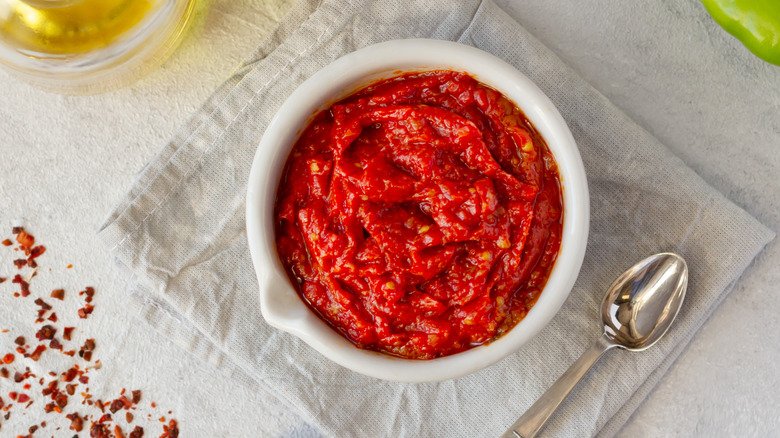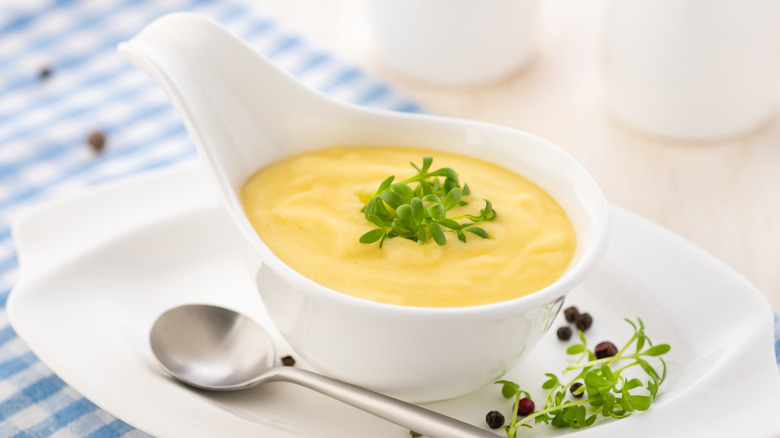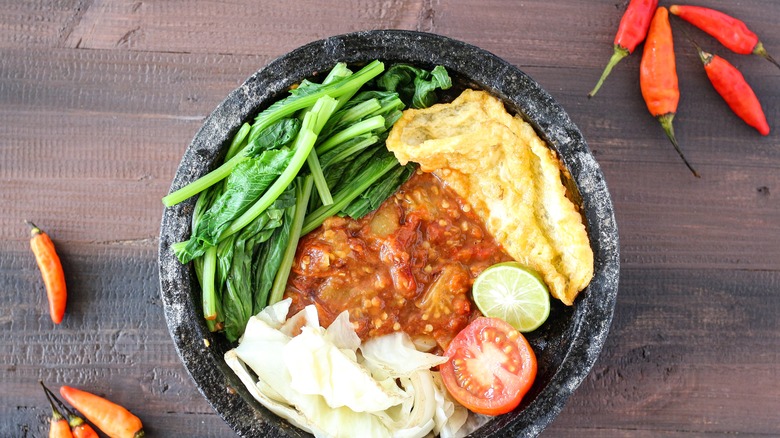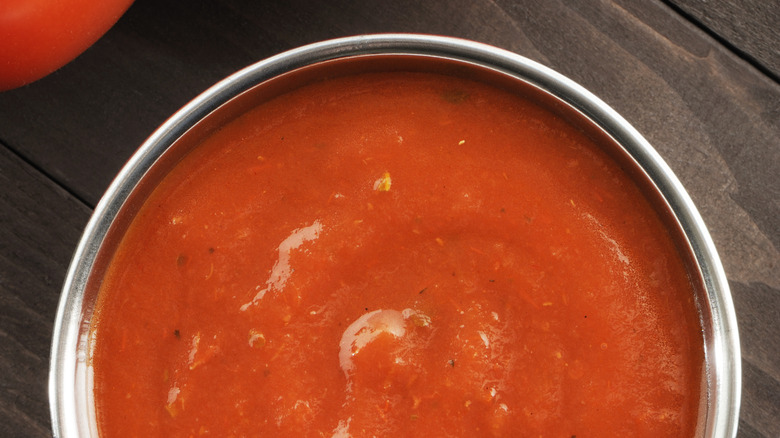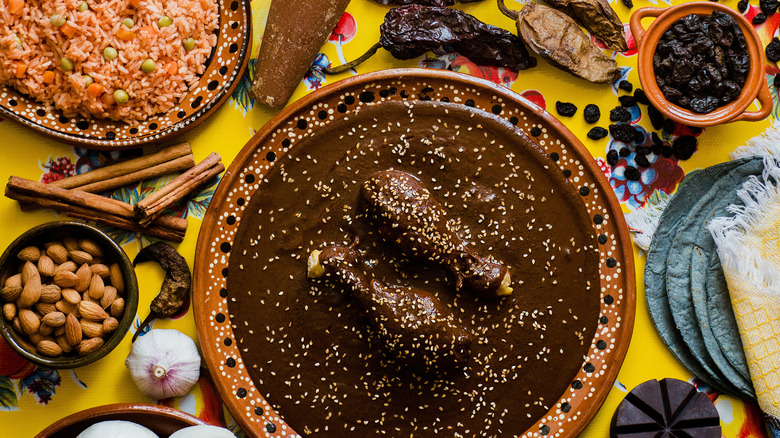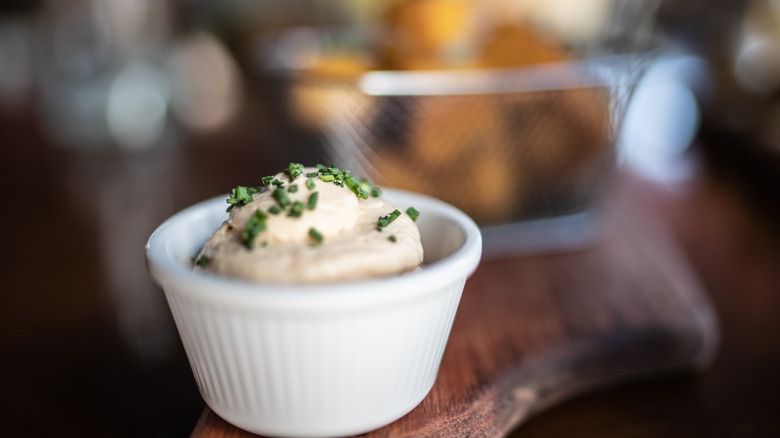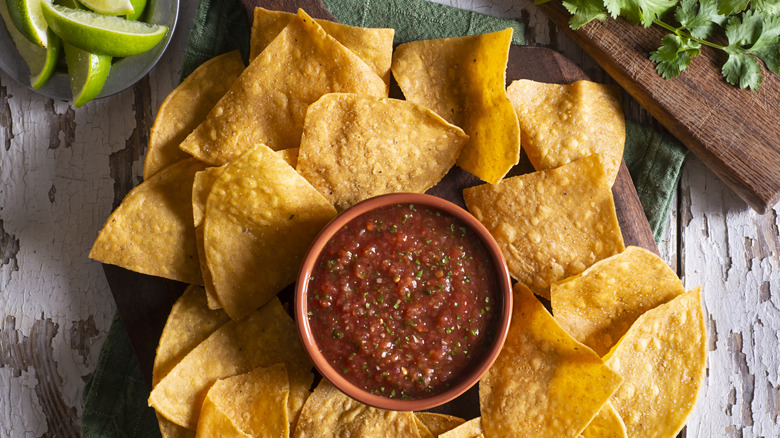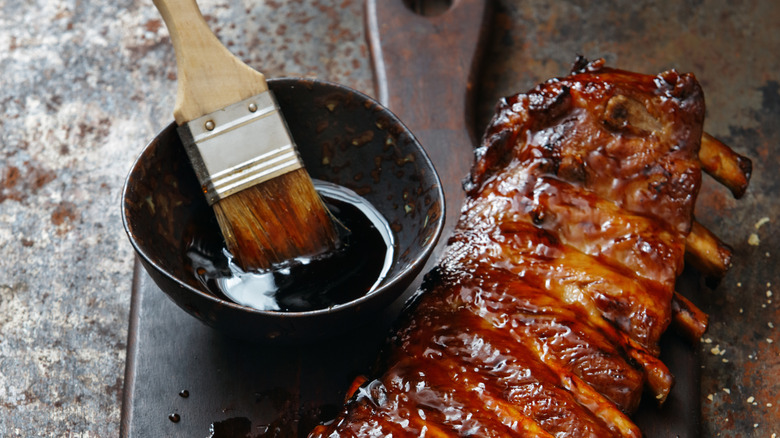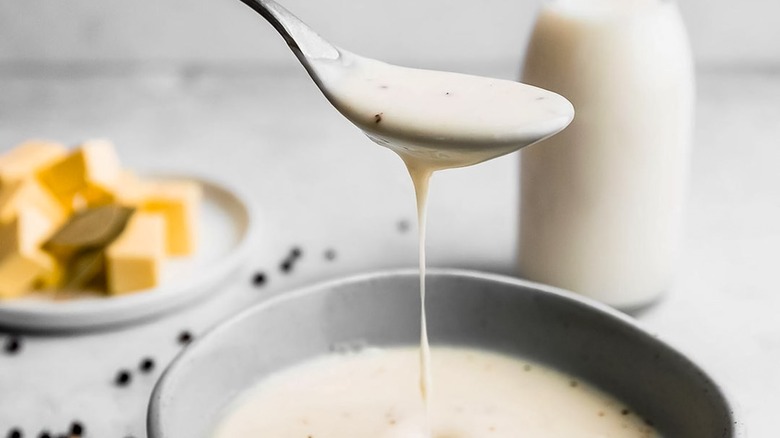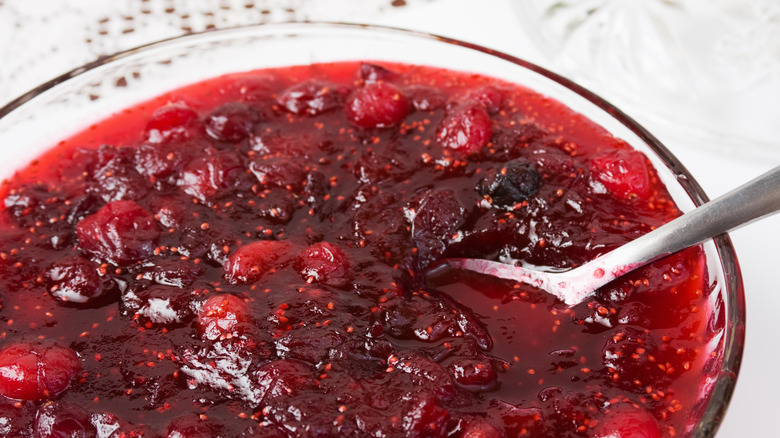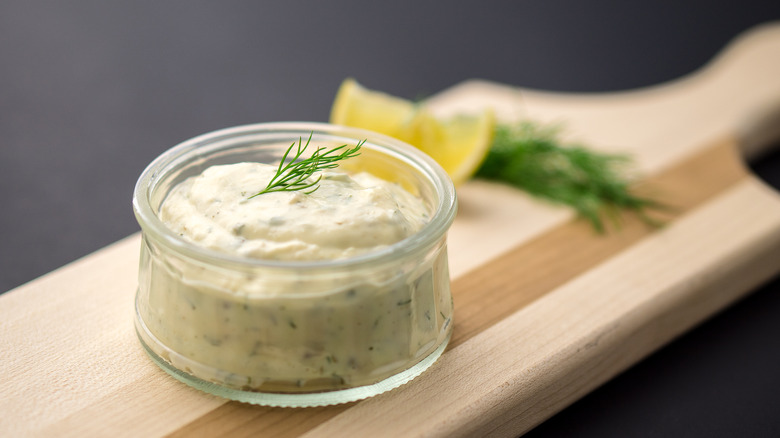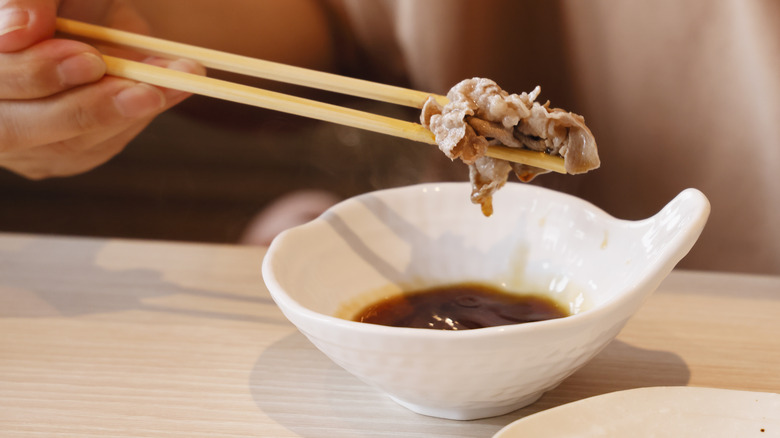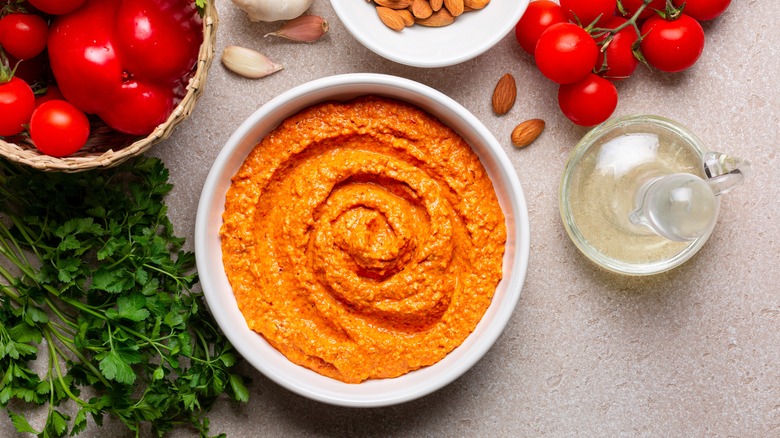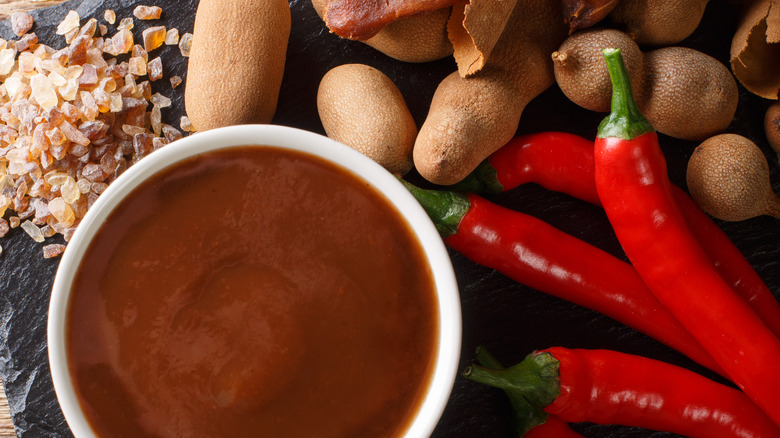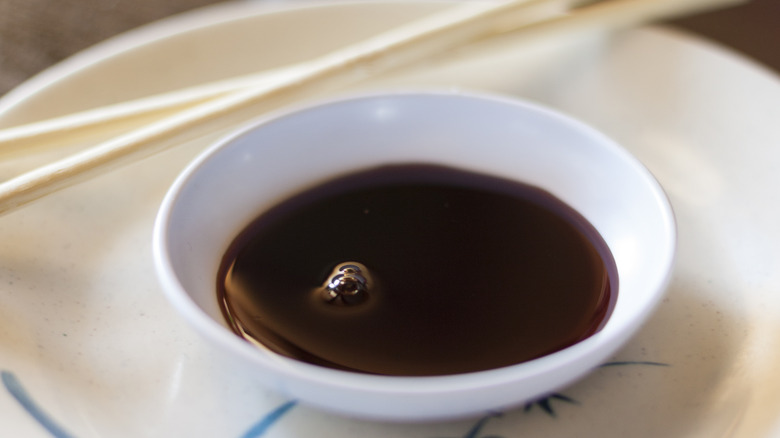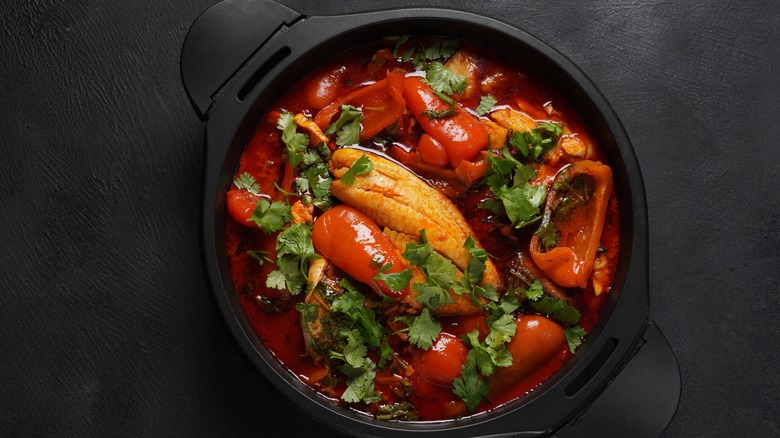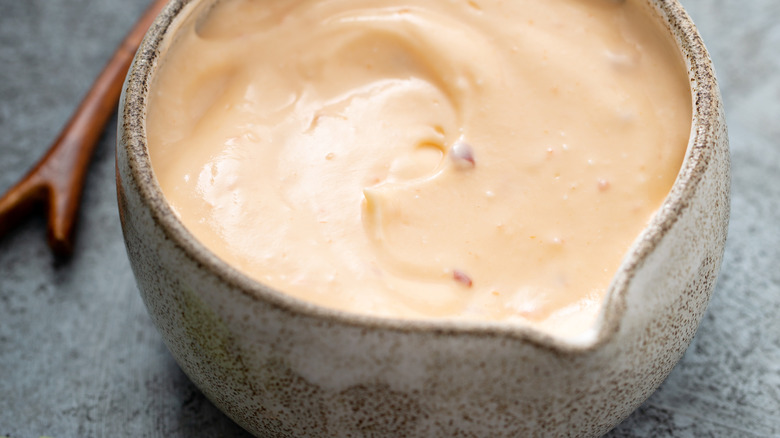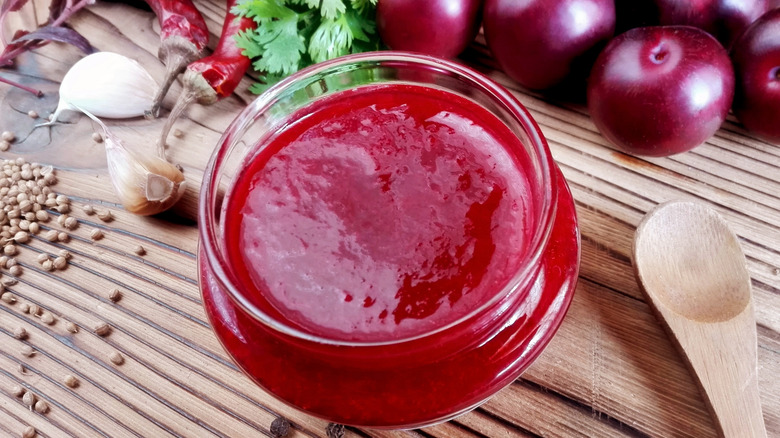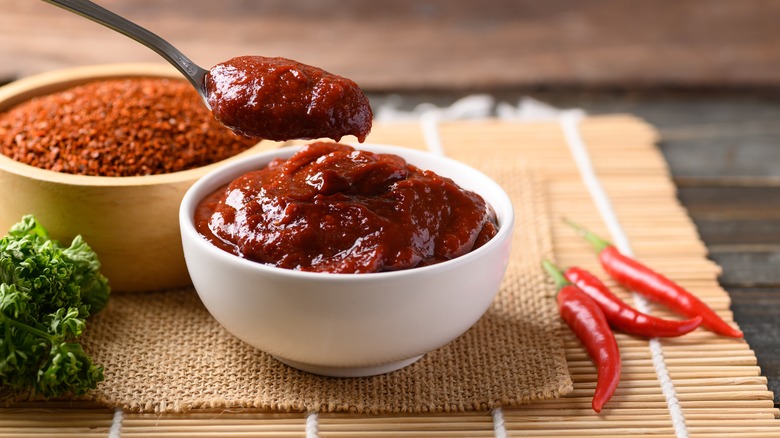30 Popular Sauces From Around The World
It can be easy to stick to your favorite basic sauces for dipping, spreading, dolloping, and drizzling. In fact, if you're from the United States, we can safely assume that you have ketchup, mayonnaise, tomato sauce, and hot sauce in your refrigerator or pantry right now. And while it's nice to stick with tried-and-true reliables, it never hurts to venture outside of your comfort zone. Not only are there endless variations on classics just waiting to tantalize your taste buds, but also new flavors that you may have never thought to pair together. Variety is the spice of life and sauce is one way to add diversity to your palate. Venture out of your comfort zone and try some of the popular sauces from around the world.
From spicy red pepper pasta sauce to umami soy dipping sauce, the options are endless. Even when you peer into a select category like gravy or chutney, each culture does it differently. The best way to expand your horizons and flex your culinary creativity is to explore and test ingredients, seasonings, herbs, and sauces you've never had the pleasure of tasting. It is, however, important to understand the flavor profile you're getting yourself into before you pair a new sauce with food, so we've listed out the most popular sauces from around the world that you need to try at least once. Let's get tasting.
Ketchup
Ketchup is a universally loved condiment that can be used in a variety of capacities. It's best known for its pairing with french fries, but it is also an ingredient found in sauces worldwide. Although it's easy to mistake the origins of ketchup with America or the United Kingdom, there's so much more you need to know about ketchup. The tomato-based vinegar sauce actually originated in Southeast Asia and was originally made with a surprising ingredient: fish sauce. Today, classic ketchup is made with tomato, vinegar, sugar, and onion powder.
Alfredo
Who doesn't love to indulge in a little pasta Alfredo every once and a while? This Italian cheese sauce is nothing short of decedent. Typically, an easy Alfredo sauce is made with parmesan cheese, cream, garlic, butter, salt, and pepper. The ingredients are whisked together in a hot pan until the cheese and butter are melted, and the sauce begins to thicken. Sometimes flour is added as a thickening agent and fresh parsley for garnish. Beyond pasta, Alfredo sauce can be used for dipping or as a sandwich spread.
Mint sauce
Mint sauce is popular in many regions of the world, differing slightly in their preparation methods and ingredients. In England, mint sauce is a popular condiment for lamb and roasted meats. In India, mint paste is made with more finely blended ingredients and spicy undertones. If you're still left wondering what mint sauce is and how to use it, there are a few key things to remember. Mint sauce is made with mint leaves and usually contains some kind of vinegar and aromatic. This sauce can be used in a variety of ways, so don't limit yourself.
Hoisin sauce
This Cantonese sauce is loaded with salty and umami flavors. Hoisin is commonly used alongside Peking duck, giving it its alternative name, "Peking sauce." The sauce is thick, salty, tangy, and slightly sweet, with rich undertones. A classic hoisin sauce recipe is made with black bean paste, soy sauce, brown sugar, fish sauce, chili paste, prunes, rice vinegar, sesame oil, and plenty of herbs, spices, and aromatics. Use it in a stir fry, or pair it with fish or meat.
Tzatziki
Let's take a trip over to Greece, the land of turquoise sparkling waters and white-domed architecture. The Greeks are known for many things, including their ancient mythology, beautiful seascapes, and of course, cuisine. A classic tzatziki recipe has a yogurt base mixed with mint or dill, lemon juice, olive oil, and garlic. Tzatziki is refreshing and tangy and is often paired with gamey meats or fish. It also tastes incredible with vegetables like cucumber or red pepper.
Chimichurri
If you've never tried chimichurri, then you're missing out. It's an herb and oil-based sauce from South America. A typical fresh chimichurri sauce is made with minced cilantro and parsley, olive oil, hot pepper flakes, vinegar, salt and pepper, and aromatics like shallots and garlic. The ingredients are mixed together and drizzled over meat, fish, or vegetable kabobs. You can even use this tangy, spicy, refreshing, and intensely aromatic sauce over grains.
Pesto
Unless you're about to go on a first date or job interview, pesto is a must-try sauce originating from Italy. Pesto is buttery, rich, herby, refreshing, slightly sweet, and intensely aromatic. Bright and fresh pesto uses a base of pine nuts, fresh basil, garlic, salt, and extra virgin olive oil. This culinary creation is one you'll want to get your hands on. Sometimes lemon juice or parmesan cheese is added for flavor and different nuts for textures. All the ingredients are minced or processed together to make a slightly chunky, oily spread or sauce.
Harissa
Let's turn the heat up a notch or two with harissa, a popular North African chili paste. Harissa is a spicy sauce made with roasted red peppers and Baklouti peppers, along with herbs, spices, and aromatics. Olive oil is added to the aromatic blend to give it depth. Harrisa is gaining popularity in the United States and can be paired with roasted vegetables, burgers, hummus, sandwiches, and meats. If you're not sure where to start, try a harissa beef pot roast recipe.
Hollandaise sauce
This French sauce is the definition of creamy. It's made with a base of egg yolks and butter, with the additions of lemon juice, cayenne pepper, and salt. A great way to ensure that your lemony hollandaise sauce recipe is extra creamy is to mix the eggs with an electric whisk. Start by heating the eggs and lemon in a double boiler for a few minutes, all the while keeping the mixture moving. This should thicken it to perfection, which is the cue that you can then add the melted butter and spices.
Sambal
What is sambal, really? This sauce has many flavorful variations, but at its core, it's an Indonesian hot chili paste. You may have seen sambal oelek in the grocery store, or Asian market, which is a sambal condiment that is available around the world. It's made by crushing a variety of fresh hot chilis, salt, and vinegar together into a paste. It's less salty and tangy than sriracha and is chunkier, as the sauce is traditionally made with a mortar and pestle.
Marinara
When it comes to pasta's best friend, marinara takes the cake. It's classic, universally loved, and adds the perfect amount of sweetness and tanginess to chewy, mellow noodles. And although you might be referring to it as tomato sauce, there is actually a difference between tomato sauce and marinara sauce. Marinara is simpler and thinner than tomato sauce, with a base of tomatoes, olive oil, and garlic, while tomato sauce often contains carrots, celery, and lots of herbs. However, both are fantastic Italian selections when it comes to pasta, pizza, or dunking mozzarella sticks or calamari.
Mole
If you think chocolate is strictly a dessert, you must have never heard of mole sauce. Mole is a South and Central American sauce made from broth, onions, garlic, chili peppers, raisins, spices, almonds, and unsweetened cocoa. Mole is slightly creamy because of the nuts and is sometimes thickened with flour. The spices and cocoa give it richness, and the peppers offer a spicy kick. Although it's typically eaten with Mexican cuisine, it can be enjoyed over your morning eggs, steak, and vegetables.
Aioli
Aioli is becoming all the rage at gastropubs, breweries, and hipster hangouts, but it has a long and rich history. Today, folks use aioli to refer to any flavored mayonnaise, although there is a real difference between aioli and mayonnaise. Aioli was originally made with whipped olive oil, garlic, lemon, and salt, while mayo contains canola oil, eggs, vinegar, and salt. And although the two have a similar consistency, aioli is likely to melt quicker and carry more flavor.
Salsa
Although salsa is famously paired with chips, it can be used in a variety of capacities. In addition, salsa has a range of preparation methods, ingredients, and flavors. Salsa can be made raw, fire-roasted, blended, chopped and chunky, green, red, spicy, or mild. There are many types of salsa, typically sharing a base of tomatoes, onion, and lime juice, although there are plenty without these key ingredients. Fresh herbs like cilantro can help to flavor the recipe. Salsa should be tangy and light and offer a substantial amount of flavor.
Barbecue sauce
American barbecue sauce comes in quite a few varieties, depending on what region of the country you're in. A basic barbecue sauce is similar to Asian hoisin sauce but is typically made with a tomato base. To make a quick barbecue sauce, simply blend and simmer together ketchup, vinegar, brown sugar, paprika, garlic and onion powder, honey, and oil. Barbecue sauce is known for its sticky sweet texture and makes the perfect addition to anything grilled over an open flame, including meats, tofu, vegetables, and some fruit.
Bechamel sauce
This simple sauce is considered a mother sauce of French cuisine. Bechamel is incredibly creamy and rich and is made with a base of butter, flour, and milk. However, there are plenty of variations that can add flavor, like the inclusion of onion, garlic, or herbs. The special method that will change your bechamel forever is to add an onion pique for about 10 minutes before removing it to infuse the sauce with flavor. Enjoy the sauce over fish, cooked into pasta dishes, chicken, or vegetables.
Sweet and sour sauce
The combination of contrasting flavors has an intriguing and powerful effect on the taste buds. Who doesn't love hot honey or a sweet and tangy vinaigrette? Sweet and sour sauce is flavor-packed and complex and is an important part of Asian cuisine. Homemade sweet and sour sauce is made with a base of sugar and vinegar and usually contains tomato and soy sauce. Cornstarch is often used to thicken the mixture and is excellent for marinading, dipping, and glazing.
Cranberry sauce
While most of us wait for our Thanksgiving turkey to enjoy cranberry sauce, it's actually a sauce that can be enjoyed all year. And if you've ever only enjoyed the canned version, consider making a sweet or savory cranberry sauce this Thanksgiving. This American classic is typically made with cooked cranberries, sugar, and citrus juice. However, many variations exist with ingredients like thyme, walnuts, celery, oranges, and cinnamon. Cranberry sauce is generally enjoyed with meat but can be spread on sandwiches, mixed with mayonnaise, and even enjoyed on baked goods.
Tartar sauce
This creamy mayo-based sauce is usually found paired with seafood because of its creamy yet tangy and refreshing ingredients. Tartar makes for a fantastic spreadable sauce on cuts of fish or can act as a dunking sauce for fried fish or other handheld seafood. But what's really in tartar sauce? It's made with mayonnaise and pickles and sometimes contains lemon juice and fresh herbs like dill or parsley. Expect a rich mouthfeel with pops of salty and vinegary flavors.
Ponzu
This Japanese soy-based sauce is great for dunking scallion pancakes, dumplings, and cuts of meat. It's salty, tangy, and rich with umami flavors. Ponzu has much more of a flavor punch compared to standard soy sauce. But what really is ponzu sauce made of? It contains tamari or soy sauce, vinegar, bonito flakes, kombu seaweed, dried dashi, and mirin. The vinegar adds tang, while the seaweed and fish flakes balance it with depth. In fact, it's almost like an Asian vinaigrette and is great on salads.
Rémoulade
Many French sauces are intensely creamy and fatty, and while this may seem redundant, French sauces are anything but that. For instance, a rémoulade sauce is quite complex, and although it has that classic mayonnaise base, it has a plethora of anterior ingredients that make it unique. Rémoulade is made with aromatics, lemon, mustard, hot sauce, horseradish, Worcestershire, and endless herbs and spices. This sauce has quite a kick and is anything but ordinary.
Romesco
While Spanish romesco features tomatoes, they don't steal the show here; peppers do. A typical smoky romesco sauce is made with red peppers, tomato, almonds, vinegar, garlic, olive oil, and paprika. The ingredients are toasted and roasted before being blended together into a thick sauce. The almonds add creaminess, the peppers add sweetness, the olive oil adds depth, and the vinegar adds tanginess. Enjoy romesco mixed with pasta, on crostini, or over meat and vegetables.
Tamarind chutney
Chutney is a fruity, chunky, sweet, and savory sauce that seems to take a different form in every culture. In India, tamarind chutney is quite popular, made from a sweet and sour fruit that looks a lot like a pod of beans. It's as tangy as citrus but has a mellow, rich sweetness that mimics caramel. Unlike jam or other fruit-based sauces, chutney pairs perfectly with robust, savory dishes to create a balance of flavors.
Poutine gravy
Everyone does gravy differently, but there are a few elements that distinguish Canadian poutine gravy from the pack. It's traditionally made with a high-quality beef broth and typically doesn't contain as many vegetables or herbs as a traditional gravy. It's tangy and has some form of tomato added to it. This sauce is poured over a bed of French fries and cheese curds to make the popular Quebec dish, poutine. And believe us, there is one ingredient you can't skip when making poutine: cheese curds.
Soy sauce
This Asian sauce is used as a base for other sauces but is also used as a sauce itself. And it's not just popular in Asia. It's likely you have a bottle of soy sauce or tamari in your refrigerator right now. It's made with a base of fermented soy and wheat and becomes a dark liquid with strong salt and umami flavors. Like most sauces, there are many variations of soy sauce, which have different uses.
Chermoula
Chermoula is a spicy North African and Middle Eastern sauce made from fresh herbs. But what is chermoula and how do you cook with it? It's thinner than chimichurri and tends to have quite a kick of spice brought on by chilis. Dill or parsley are minced and mixed with bold ingredients like lemon juice or zest, ginger, and saffron. Other spices like cumin, coriander, and cardamom elevate the unique flavor. Chermoula can be mixed with olive oil to become a delicious marinade, but it also makes for a delicious bread dip or a refreshing yet spicy sauce when mixed with yogurt.
Russian dressing
Russian dressing, which is usually made the same way as thousand island dressing, is creamy, chunky, tangy, and slightly sweet. An easy Russian dressing is typically made with mayonnaise, diced onion, ketchup, horseradish, Worcestershire sauce, paprika, and salt. This dressing is pink and sometimes contains varying ingredients like pickles, capers, or parsley. Add Russian dressing to sandwiches like Reubens, use it for dipping fried foods, use it to top fish, slather it on a burger, or drizzle it over a salad.
Tkemali
Tkemali, also known as Georgia ketchup, is made with plums instead of tomatoes. In fact, the dish can be made with either ripe purple plums or unripe sour plums, which gives it a pronounced tangy flavor. In combination with ingredients like garlic, fennel, and paprika, fresh herbs like cilantro, spearmint, pennyroyal, and chives are essential to giving tkemali that fresh and distinct flavor. Georgia plum tkemali sauce is typically paired with meats and potatoes but can make a great topping for eggs and vegetables as well.
Spicy peanut sauce
Although peanut butter is a popular American spread, ground creamy peanuts are used in cuisine all over the world. In Thai cuisine, spicy peanut sauce is used for dipping, drizzling, and mixing into curries. Because dairy isn't a common ingredient in Thai cooking, coconut milk, and peanut sauce are added to make dishes rich, creamy, and irresistible. Ground peanuts are mixed with chili paste, lime juice, garlic, ginger, and soy sauce. Sometimes sugar is added for delicately balanced sweetness.
Gochujang
No matter where you are in the world, people crave hot sauce. In Korea, gochujang is a popular sauce used to give food an extra pop of heat and flavor. It's made with chili peppers, fermented soybean powder, salt, and other ingredients. It's deeply spicy, which is the reason gochujang is often diluted when added to dishes. It's concentrated, thick, and salty; need we say more? Gochujang can be spread on meats, enjoyed in rice bowls, or used as an ingredient to make soups or other sauces sing.
